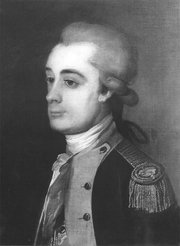Samuel Bentham
|
|
Sir Samuel Bentham (11 January 1757 - 31 May 1831) was a noted mechanical engineer credited with numerous innovations, particularly related to naval architecture, including weapons. He was also the brother of philosopher Jeremy Bentham.
At the age of 14, Bentham was apprenticed to a shipwright at Woolwich Dockyard, serving there for seven years. In 1780 he moved to Russia, where he was employed in the service of Prince Potemkin, who had an establishment designed to promote the introduction of various arts of civilization. Though he was initially hired as a shipbuilder, Bentham soon became responsible for multiple tasks, and eventually came to have complete responsibility over the administration of Potemkin's estate. He was in charge of a battalion of a thousand men, and the complexities involved in dealing with such a workforce led Bentham to conceive the idea of central inspection, out of which emerged the panopticon project popularized by his brother Jeremy.
In 1782, Bentham travelled through Siberia to China, visiting Kyakhta and its Chinese pendant Naimatchin, and then spending over a month at the border fluvial city of Nerchinsk, where he was able to study Chinese ship designs, particularly those of junks. Back in Europe, he campaigned for the introduction of watertight compartments, an idea which he acknowledged he had got from seeing large Chinese vessels in Siberia. In 1795 the Lords Commissioners of the Admiralty asked him to design six new sailing ships with "partitions contributing to strength, and securing the ship against foundering, as practiced by the Chinese of the present day". These were built at a ship-yard at Redbridge, Hampshire, and incorporated a number of other novel features such as interchangeable parts for masts and spars, allowing easy maintenance while at sea.
In 1795, Bentham was appointed by the Admiralty to be its first (and only) Inspector-General of Naval Works. He was tasked with continuing the modernisation of Portsmouth Dockyard, and in particular the introduction of steam power and mechanisation of production processes in the dockyard.
Bentham is credited with helping to revolutionise the production of the wooden pulley blocks used in ship's rigging, devising woodworking machinery to improve production efficiency. His efforts were augmented by those of Marc Isambard Brunel and Henry Maudslay, marking the arrival of mass production techniques in British manufacturing at the Portsmouth Block Mills.
VauxhallBridge1829.gif
Bentham also designed a full cast-iron nine-arch bridge project for the Butterly company, for the Vauxhall Bridge in London, which was to become the first iron-built bridge over the Thames. The choice of cast iron was said to be because it was "cheaper than masonry", but some of the inspiration for the bridge has also been traced to Bentham's experience of China, where numerous such arched iron-cast bridges existed. The design was eventually abandoned after doubt about its quality, in favour of a "cast iron arches on masonry piers" design by James Walker. The bridge was completed in May 1813.
His son George Bentham, born in 1800, became a noted botanist.
References
- Jonathan Coad, Sir Samual Bentham in A Biographical Dictionary of Civil Engineers, 2002, pp 52-53
- Catherine Pease-Watkin, 'Jeremy and Samuel Bentham ? The Private and the Public (http://www.ucl.ac.uk/Bentham-Project/journal/cpwsam.htm),' Journal of Bentham Studies 5, 2002.
- "The Benthams in Russia, 1780-1791", Ian R. Christie, Berg Oxford, ISBN 0854968164

